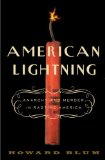Summary | Excerpt | Reviews | Beyond the Book | Readalikes | Genres & Themes | Author Bio
Terror, Mystery, the Birth of Hollywood, and the Crime of the Century
by Howard Blum

Critics' Opinion:
Readers' Opinion:
First Published:
Sep 2008, 352 pages
Paperback:
Oct 2009, 352 pages
 Book Reviewed by:
Book Reviewed by:
Jamie Kuhns
Buy This Book
From the start, Otis came out fighting. The Times, like the city’s three other dailies, the Herald, the Express, and the Tribune, was a union shop, and in the spring of 1890 he decided to do something about that. Under Otis’s leadership, the dailies banded together and announced that they wanted the typographers to accept a 20 percent wage cut. The outraged typographers shot back with their own ultimatum: The owners had twenty-four hours to sign an agreement extending the existing pay scale for another year, or they would go on strike.
The owners refused to accept the terms—at first. After only a day, the Tribune signed. The Express held out for three days. The Herald stood firm for three long and bitter months before it acquiesced. But Otis would not settle. The union men who had walked away from their jobs, he announced, would never return. Their positions would be taken by nonunion workers. Which, after all, had been his objective from the start.
The Times’s pressroom became a combat zone. Union workers fought with “scab” typographers brought in from Kansas City. Otis, convinced of both the moral and the economic necessity of his position, was relentless. News articles and vituperative editorials in the Times kept up a continuous assault on the printers’ union and closed-shop unionism.
The dispute spilled out of the Times Building and spread across the city. Pickets blocked the entrances of stores that advertised in the Times, urging customers not to enter. Merchants who withdrew their advertising were attacked by name in the paper as “cowards and cravens.” Unions throughout the country announced their support for the printers, and capitalist associations hailed Otis as a hero.
Within months a pressroom labor dispute had taken on a galvanizing momentum. The city was on edge, bristling with a combative politics. It was as if all of Los Angeles had chosen sides. When Eugene Debs, the Socialist Party leader, announced a national railroad strike, 100,000 Pullman workers around the country walked off their jobs. Los Angeles was immobilized. On June 27, 1894, cargo trains sat abandoned on the tracks. Nothing could come in or go out of the city on rail; and these new frustrations and deprivations ignited the already incendiary mood. Rioting broke out in the streets. The Times Building, a rallying symbol for both labor and capital, became the center of the conflict.
Blood spilled for an entire week. Union men and sympathizers attacked “scabs,” ambushed paper carriers, and destroyed press runs before the issues could be distributed. Wielding ax handles, paid strikebreakers sought out union members and went after them with a professional, methodical violence. The fighting was hand to hand and unforgiving. Six armed U.S. infantry companies had to be deployed on the streets before the bloodshed could be stopped.
Otis was not deterred. The riots were, he firmly believed, only the opening salvo in a war that would not be over until the unions were driven out of Los Angeles. Compromise would be surrender. Rather than negotiate, he prepared for new battles. He now called himself “General.” He christened his sprawling home “the Bivouac.” He mounted a cannon on the hood of his limousine and made sure his chauffeur was prepared to repel, at his command, any enemy attacks. He modeled the paper’s new printing plant on a fanciful vision of an impregnable fortress, complete with battlements, sentry boxes, and firing holes offering protected lines of fire at any mob that dared to storm his citadel. Impatient, full of a warrior’s gusto, he waited for the conflict he was certain would come.
His greatest supporter was his son-in-law, Harry Chandler. With unquestioning devotion, Chandler played the roles of ally, confidant, military aide-de-camp, and assistant publisher. He had quit Dartmouth at eighteen and headed west in the hope of curing himself of tuberculosis. Arriving in Los Angeles, he had found work in the Times’s circulation department. His rise was meteoric. As Time magazine glibly recounted it, “Young Chandler did his job so well that he attracted the General’s eye, got a promotion, married the General’s daughter.” The two men were now a team, determined to bring Los Angeles into the new century as a bustling, nonunion metropolis.
Excerpted from American Lightning by Howard Blum. Excerpted by permission of Crown, a division of Random House, Inc. All rights reserved. No part of this excerpt may be reproduced or reprinted without permission in writing from the publisher.





The Flower Sisters
by Michelle Collins Anderson
From the new Fannie Flagg of the Ozarks, a richly-woven story of family, forgiveness, and reinvention.

The House on Biscayne Bay
by Chanel Cleeton
As death stalks a gothic mansion in Miami, the lives of two women intertwine as the past and present collide.

The Funeral Cryer by Wenyan Lu
Debut novelist Wenyan Lu brings us this witty yet profound story about one woman's midlife reawakening in contemporary rural China.
Your guide toexceptional books
BookBrowse seeks out and recommends the best in contemporary fiction and nonfiction—books that not only engage and entertain but also deepen our understanding of ourselves and the world around us.